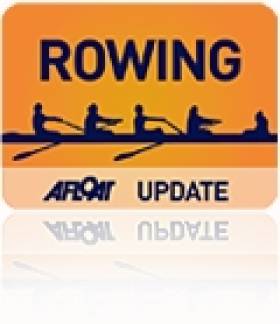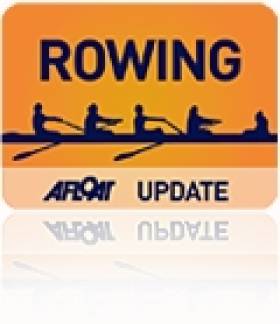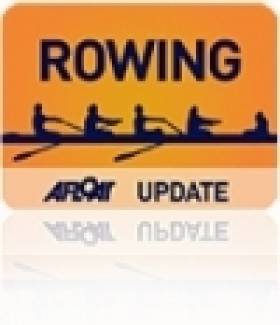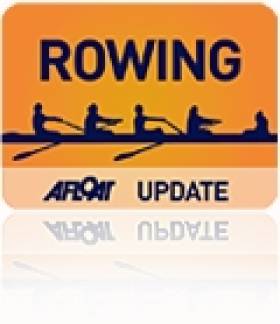Displaying items by tag: rowing
Moynihan and Nixon Fastest Scullers
Cathal Moynihan was the fastest single rowing sculler at the inaugural two-blade National Head, hosted by St Michael’s in O’Brien’s Bridge. Holly Nixon, a junior, was the fastest woman. Juniors also did well in the pairs events, with Presentation joint fastest men’s crew with St Michael’s. The women’s event was won by Skibbereen.
The fastest crew overall at the head, which was held in perfect conditions, was the powerful NUIG/Grainne Mhaol eight.
St Michael’s Head of the River, O Brien’s Bridge, Clare, Saturday (Selected Results)
National Two-Blade Head of the River
Men’s Pair – Overall: 1= St Michael’s intermediate (M O’Brien, D O’Connor) 12 minutes 08 and Presentation College junior 18 12:08, 3 Commercial 12:09, 4 UCD senior pair 12:12, 5 Bann junior 18 12:16, 6 Trinity intermediate 12:21.
Senior: 1 Commercial 12:09, 2 UCD 12:12, 3 Skibbereen 12:23. Intermediate: St Michael’s 12:08. Novice: Fossa 14:41. Junior 18: Presentation 12:08.
Men’s Single Scull – Overall: 1 Muckross (C Moynihan; senior) 12:27, 2= Fossa (Folan; senior) 12:34 and Skibbereen (O’Donovan, junior) 12:34, 4 Fossa (Mannion) 12:40, 5 UCD (Neal; intermediate) 12:46, 6 Trinity (McCaffrey) 12:53.
Senior: Muckross (Moynihan) 12:27, 2 Fossa (Folan) 12:34, 3 Fossa (Mannion) 12:40. Intermediate: UCD (Neal) 12:46. Novice: Trinity (McCaffrey) 12:53. Junior 18: Skibbereen (O’Donovan) 12:34. Junior 16: Commercial (Geoghegan) 13:20. Masters: Clonmel (Kinsella) 14:09.
Women’s Pair – Overall: 1 Skibbereen (senior) 13:39, 2 Killorglin (senior) 13:51, 3 Trinity (senior) 14:07.
Senior: 1 Skibbereen 13:39, 2 Killorglin 13:51, 3 Trinity 14:07. Novice: Shannon 15:22. Junior 18: St Michael’s 14:16.
Women’s Single Scull – Overall: 1 Portora (H Nixon; junior) 13:48, 2 Killorglin (Dukarska, senior) 13:52, 3 Skibbereen (Walsh, intermediate) 13:56, 4 St Michael’s (Clavin, senior) 14:06, 5 Three Castles (Quinn, senior) 14:06, 6 NUIG (Hurst, intermediate) 14:11.
Senior: Killorglin (Dukarska) 13:52. Intermediate: Skibbereen (Walsh) 13:56. Novice: Trinity (Dowling) 17:07. Junior 18: Portora (Nixon) 13:48. Junior 16: Commercial (Keating) 14:20. Masters: Cork (Crowley) 16:58.
Head of the River (Rolling)
Men, Eight – Senior: Grainne Mhaol/NUIG 9:55. Intermediate: UCD 10:39. Novice: UCC 10:59. Junior 18: St Joseph’s 11:16. Junior 16: Commercial 11:47. Masters: Fermoy 11:27
Four – Senior: Grainne Mhaol/NUIG 10:32. Intermediate: Neptune, coxed 11:39. Novice: UCC, coxed 11:50. Junior 18: Portora 10:37. Junior 16: Cork (junior 15 quadruple) 12:05. Masters: Muckross 13:11
Doubles/Pair – Senior: Muckross/University of Limerick double 11:30. Intermediate: Neptune double 12:04. Novice: Shannon 12:44. Junior 18: Portora double 11:50. Masters: Commercial double 13:11.
Sculling, single – Junior 16: St Joseph’s College (Egan) 14:28.
Women,
Eight – Senior: 1 Trinity 11:34, 2 UCD 11:47, 3 UCD 12:16. Intermediate: Trinity 10:13. Junior 18: St Michael’s 11:34.
Four – Senior: UCD 12:40. Intermediate: Skibbereen 11:59. Junior 18: Portora 12:10.
Pair/Double – Senior: University of Limerick double 15:31. Intermediate: St Michael’s 13:36.
Click this link for Irish Rowing detailsClick this link for the Latest Rowing News
O'Brien's Bridge is Venue for First Head of River Race
Over one thousand rowers from clubs across the country, including crews from Northern Ireland, will gather at O'Brien's Bridge in Co. Clare for Rowing Ireland's first National Head of the River race of 2011 this weekend.
St Michael's Rowing Club, Limerick is hosting this weekend's competition, which is the first event of the 2011 rowing season, and is a national two blade event, that is, single sculls and coxless pairs.
The Head chairman Robert LeGear, said today, "We're delighted with the massive entry so early in the season. It's a sure sign of the interest and growth in club rowing. All we need now is fair weather for the event."
He added, "One hundred and twenty two boats will compete in the morning's Men's pairs and Women's single sculls, which get underway at 11.00 am. In the afternoon, one hundred and sixty six boats will compete in the Men's singles and Women's pairs which start at 2.00 pm.
The O'Brien's Bridge course is a favorite with rowers because of the calm stretch of water it offers. St Michaels have been running their own head of the river race here for over twenty eight years.
National Head of the River races are time trials with senior boats going off first and then working down through all the grades to under-fifteens. The race caters for men and women in singles and pairs at all levels, under 15, 16, 18, Novice, Intermediate and Senior.
Other boat categories will be on offer throughout the day in a rolling head time trial competition which gets underway at 9 am and runs until 4 pm.
The main National Head races take place at 11.00 am and 2 pm.
Click this link for Irish Rowing detailsClick this link for the Latest Rowing News
Puspure and Under-23s the Indoor Stars
Under-23 athletes and heavyweight single sculler Sanita Puspure were the stars of the show at the Rowing Ireland Indoor Championships at Dublin City University. Puspure was by far the fastest woman, in 6 minutes 49.4 seconds, but Eimear Moran of Offaly also impressed – and qualified for the international programme – with a time of 6:57.0. Claire Lambe competed in the under-23 category, but was the fastest lightweight woman, while Lisa Dilleen won the under-23 Open category.
Michael Maher of Three Castles headed the men’s lightweight rankings, but the next three fastest lightweights were under-23 competitors – Justin Ryan, Niall Kenny and Sean Prendeville. The fastest heavyweight man was Colin Williamson of Queen’s University, who was disappointed not to break six minutes for the '2,000-metre' test. He won a good battle with Sean Jacob and Eoin Mac Domhnaill. These three alone made it inside the qualifying standard in this class. Christ Jeffers of Belfast Rowing Club was the fastest under-23 heavyweight.
The absence of athletes from some clubs due to the inclement weather left Ireland performance director Martin McElroy with no option but to allow those who had entered but not been able to make it to qualify at the next time trial in February.
National Indoor Championships, Dublin City University, Saturday (selected results; international qualifying standard in parentheses)
Men
Open (6 minutes 10 seconds): 1 C Williamson (Queen’s University) 6 minutes 01.7 seconds, 2 S Jacob (Old Collegians) 6:04.4, 3 E Mac Domhnaill (Queen’s) 6:08.3; 4 M Ewing (Queen’s) 6:13.9, 5 A Mohamed (Queen’s) 6:14.8, 6 J Corcoran (Neptune) 6:19.6.
Open Lightweight (6:36): 1 M Maher (Three Castles) 6:17.0, 2 P Healy 6:24.5, 3 A English (UCD) 6:25.0; 4 M O’Donovan 6:27.0, 5 M Bailey (Neptune) 6:29.5, 6= D Hannon (Queen’s) and P Noonan (University of Limerick) 6:35.5.
Under-23 (6:19.1; under-20s - 6:25.3): 1 C Jeffers (Belfast RC) 6:13.5, 2 T Hughes 6:18.6, 3 C Doorley (University of Limerick) 6:21.9; 4 J McKay (Belfast RC) 6:23.7, 5 F Folan (Three Castles) 6:24.6, 6 D Power (St Michael’s) 6:28.1.
Under-23 Lightweight (6:45.7; under-20s - 6:52.3): 1 J Ryan (UCC) 6:19.5, 2 N Kenny (NUIG) 6:20.1, 3 S Prendeville (Muckross) 6:20.9; 4 P Hanily (UCC) 6:26.6, 5 J Mitchell (Queen’s) 6:28.5, 6 C Dowling (Commercial) 6:36.2, 7 A Prendergast (Clonmel) 6:43.4, 8 C Clifford (UCD) 6:43.7, 9 S Egan (Athlone) 6:49.2, 10 C Hamersly (University of Limerick) 6:50.8.
Junior 18 (6:55.0): 1 A Sheehan (Castleconnell) 6:26.3, 2 F Tolan (St Joseph’s) 6:29.7, 3 N Prendiville (University of Limerick) 6:36.1; 4 M Pukelis (Offaly) 6:36.6, 5 A Griffin (Neptune) 6:37.3, 6 C Kelly (Carlow) 6:38.2.
Junior 16 (7:08.4): 1 A McGrath (Carlow) 6:48.6, 2 M Hall (Blackrock College) 6:49.6, 3 J Casey (Shandon) 6:55.9; 4 K Keohane (Presentation College) 6:56.1, 5 D Buckley (Cork BC) 6:57.1, 6 J Egan (St Joseph’s College) 6:59.1.
Adaptive (1,000 m) – Legs, Trunk and Arms: S Ryan (Castleconnell) 3:05.0. Arms Only: K Doherty (City of Derry 4:13.3.
Women
Open (6:59.7): 1 S Puspure (Old Collegians) 6:49.4, 2 E Moran (Offaly) 6:57.0, 3 A O’Sullivan (University of Limerick) 7:08.9; 4 C Duffy (Imperial College) 7:11.8, 5 H McCormack (Challenge Ten) 7:34.3, 6 S O’Brien (Garda) 7:39.1.
Open Lightweight (7:38.1): 1 O Hayes (Skibbereen) 7:19.9, 2 B Quinn (Three Castles) 7:25.2, 3 S Jacob (Old Collegians) 7:25.8, 4 S McCrohan (Tribesmen) 7:28.4, 5 K Corcoran O’Hare (Shandon) 7:47.2.
Under-23 (7:10.0; under-20s – 7:17.0): 1 L Dilleen (CIT) 6:57.4, 2 M Dukarska (Killorglin) 7:07.6, 3 S Bennett (UCD) 7:09.9; 4 D McCarthy (NUIG) 7:20.5, 5 J O’Keeffe (University of Limerick) 7:27.2, 6 F McGrath (St Angela’s Ursuline Col) 7:46.8.
Under-23 Lightweight (7:49.2; under-20s – 7:56.9): 1 C Lambe (UCD) 7:16.8, 2 Sarah Dolan 7:23.6, 3 C Hurst (NUIG) 7:39.4, 4 Sinead Dolan (Trinity) 7:45.8.
Junior 18 (7:50.8): 1 R Shorten (Methodist College) 7:22.4, 2 C Harrison (Methodist Col) 7:23.3, 3 A Crowley (Killorglin) 7:30.6; 4 C Deasy (Cork) 7:42.0, 5 M Gregson (Methodist Col) 7:43.6, 6 N O’Mahony (Shandon) 7:43.9.
Junior 16 (8:06): 1 B Jacques (Methodist Col) 7:25.8, 2 H Shinnick (Fermoy) 7:32.5, 3 L Hamel (Lee) 7:48.6; 4 A Rodger (Commercial) 7:52.7, 5 A Cooper (Muckross) 7:56.1, 6 R Gilligan (Shannon) 7:57.9.
Adaptive (1,000 m) – Legs, Trunk and Arms: A Molkenthin 3:38.3.
Photos from the weekend HERE
Click this link for Irish Rowing detailsClick this link for the Latest Rowing News
Newry Assessment Cancelled
The Five-Kilometre National Assessment fixed for Newry on Sunday has been cancelled. Ireland Rowing performance director Martin McElroy said that the forecast was for very low temperatures in the area and the canal may be frozen.
McElroy said that the ergometer tests at the National Indoor Championships in Dublin City University on Saturday will still function as a selection procedure for the next assessment in February.
The Championships have drawn a big entry, with a schedule running from 9.15 am until the final race, which is fixed for 4pm.
Click this link for Irish Rowing detailsClick this link for the Latest Rowing News
Afloat Honours Puspure's Indoor Achievement
Sanita Puspure is the Afloat Rower of the Month for November. The Old Collegians sculler had an outstanding result at the the British Indoor Rowing Championships. She took silver in the open women’s category – only 3.2 seconds behind double Olympic medallist Debbie Flood, and in a time (6 minutes 51.9 seconds) which was faster than Flood’s winning time last year. The Championships also showcased the talents of Adrian Sheehan of Castleconnell, who won the junior lightweight event.
Rower of the Month Awards: The judging panel is made up of Liam Gorman, rowing correspondent of The Irish Times, President of Rowing Ireland Anthony Dooley and David O'Brien, Editor of Afloat magazine. Monthly awards for achievements during the year will appear on afloat.ie and the overall national award will be presented to the person or crew who, in the judges' opinion, achieved the most notable results in, or made the most significant contribution to rowing during 2010. Keep a monthly eye on progress and watch our 2010 champions list grow.
Click this link for Irish Rowing detailsClick this link for the Latest Rowing News
Muckross Head of the River Cancelled
Muckross Head of the River, scheduled for Saturday, has been cancelled. Snow and below zero temperatures are forecast for the rowing venue, along with strong winds.
Click this link for Irish Rowing detailsClick this link for the Latest Rowing News
O'Neill Honoured in New Zealand
Rowing vet Sean O’Neill from Limerick has been honoured in New Zealand. The Limerickman was this week named the Marlborough Express/Blenheim Round Table Sportsperson of the Year. O’Neill’s father, Tom, attended the ceremony in Marlborough. The 30-year-old came out on top in a contest which featured 32 other nominees.
Sean O’Neill rowed with Ireland at the Olympics in Beijing in 2008, but he has long been resident in New Zealand, and began rowing there after travelling out to study and play rugby in Wellington. He is now established in the the New Zealand rowing squad and rowed in the six seat in the New Zealand senior eight which competed in the A Final on home waters at the recent World Championships on Lake Karapiro. His achievements this season also include a bronze medal in the four at the World Cup in Lucerne and being part of the eight which reached the final of the Grand Challenge Cup at Henley Royal Regatta.
Click this link for Irish Rowing detailsClick this link for the Latest Rowing News
Irish Rowing News. Rowing Clubs, Regattas, Sculling & Coastal Rowing
Afloat's rowing coverage encompasses the widest range of activities undertaken on Irish lakes, rivers and coastal waters. We aim to bring jargon free reports separated in to popular categories to promote the sport in Ireland.
Click this link for the latest Irish Rowing News and Results.
Rowing is one of the oldest of all sports, and FISA (Federation des Societes d'Aviron) the governing body of the sport, which was founded in 1892, is the oldest international sports federation in the Olympic movement. FISA has 128 member federations worldwide, organises World and Olympic Championships and World Cups and promotes all forms of rowing – including the non-Olympic event of Coastal Rowing.
The Irish Amateur Rowing Union, a federation of rowing clubs, has a history almost as long as the international body: it was founded in Dublin in 1899. Now reconstituted as Rowing Ireland, in 2010 the union had 69 affiliated clubs spread throughout the island of Ireland and 2,500 registered athletes. The National Rowing Centre is based at Farran Wood on Inniscarra Lake in County Cork. The domestic season traditionally culminates in the National Championships in mid-July.
Rowing is divided into sweep rowing and sculling. Sweep rowing involves the participant using both hands on one oar; in sculling the participant holds one oar in each hand. Boats may include a cox (coxwain), who generally steers the boat by means of wires, and guides and rallies the crew. In the shorthand of the sport, coxless crews are denominated by a minus (e.g. a men's coxless four is M4-). Senior sculling crews generally do not include a cox. The set distance for competition in regattas is 2,000 metres. Six-lane racing is standard.
The Olympic Games are the highest level at which rowers compete: there are 14 Olympic rowing classes, eight for men and six for women. Only three of these are in the lightweight classification, the most successful one for Irish rowers: men's fours (LM4-) and double sculls (LM2x) and women's double sculls (LW2x).
Individual oarsmen in lightweight crews cannot exceed 72.5 kilograms, and the average weight of a lightweight crew, excluding the cox, cannot be over 70 kgs. A single sculler cannot be above 72.5 kgs. The equivalent for women are 59 kgs (highest weight) and 57 kgs (average for oarswomen in a crew).
Ireland's best results at the Olympic Games came in 1996 and 1976. At Lake Lanier in the 1996 Games the men's lightweight coxless four crew of Tony O'Connor, Neville Maxwell, Sam Lynch and Derek Holland were beaten by less than a second for the bronze medal. In 1976 in Montreal Sean Drea finished fourth in the men's single sculls. In 2004 the Ireland lightweight four finished sixth in Athens.
The annual World Rowing Championships feature the 14 Olympic events and eight others for able-bodied athletes along with four adaptive events. The Championships have been a much happier hunting ground for the Irish, especially in the non-Olympic events. Niall O'Toole won gold in the lightweight single scull in 1991 and in 2001 Ireland won three World Championship golds: Sam Lynch (lightweight single scull); Sinead Jennings (women's lightweight single) and Tony O'Connor and Gearoid Towey (lightweight pair). Lynch sucessfully defended his title in 2002.
After the Olympics and the World Championships, the third big rowing competition is the World Cup series, usually three regattas in Europe. The World Under-23 Championships, the World Junior Championships, and, for countries in these islands, the Home Internationals, are also big international events. The European Championships were revived in 2006 after a three-decade break and Ireland took part in 2010.
Henley Royal Regatta, with the finals in July each year in the English town, has a special place in the calendar due to its history and its social aspect.
Our coverage though is not restricted to the Republic of Ireland but encompass Northern Ireland Scotland, Wales and the Irish Sea area too.
We're always aiming to build on our rowing content. We're keen to build on areas such as online guides on rowing. If you have ideas for our pages we'd love to hear from you. Please email us at [email protected]
Queen's Fifth in Fours Head in London
Queen’s Unversity’s rowing elite four of Colin Williamson, Rory O’Connor, Abdulrahman Mohamed and Jonathan Mitchell finished fifth at the Fuller’s Fours Head of the River in London today.
At the Bann Head of the River on Saturday, the host club’s junior 18 eight were the fastest crew.
Fuller’s Fours Head of the River, London, Sunday (Provisional Results; Irish interest):
1 Leander III (elite lightweight quadruple) 18 minutes 18.24 seconds; 5 Queen’s University elite quadruple 18:20.88; 39 UCD/Three Castles elite four 19:16.1; 45 UCD/Skibbereen/NUIG elite four 19:18.17; 58 Queen’s II elite four, coxed 19:26.28; 152 Trinity/UCD/Queen’s/City of Derry women’s elite quadruple 20:18:05; 160 Cork elite quadruple 20:20.03; 189 Tribesmen/Killorglin/Limerick women’s elite quadruple 20:31.12; 314 Queen’s women’s elite four 21:27.12.
Bann Head of the River, Coleraine, Saturday –
First Head - Overall: 1 Bann junior 18A four 14:08.74, 2 RBAI quadruple, coxed 15:08.15, 3 CAI four, coxed 15:39.59.
Men, Four - Novice, coxed: Carrick-on-Shannon 17:11.50. Junior 18A: Bann 14:08.74. Masters, coxed: Belfast BC 17:29.05.
Sculling, Quadruple, coxed: RBAI 15:08.15.
Single – Junior 18A: Carrick-on-Shannon (Cox) 17:37.50. Junior 16: CAI (Gibson) 18:31.47. Masters: Lady Elizabeth (Smyth) 18:07.39.
Women, Intermediate four, coxed: Queen’s 17:33.45.
Sculling, Quadruple – Junior 16, coxed: Bann 17:55.59. Single – Junior 18: Portadown (Lindsay) 25:15.85. Junior 16: Portadown (McKavanagh) 23:28.23.
Second Head – Overall: 1 Bann junior 18A eight 13:22.84, 2 CAI junior 18A eight 14:46.70, 3 Carrick-on-Shannon junior 18A quadruple 14:47.49.
Men, Eight – Novice: Queen’s 16:31.32. Junior 18: Bann 13:22.84, 2 CAI 14:46.70, 3 RBAI 14:48.70. Junior 16: Bann 14:56.92. Masters: Belfast RC A 16:17.43
Sculling, Quadruple – Senior: Portadown 17:12.88. Junior 18A: Carrick-on-Shannon 14:47.49.
Double – Intermediate: Carrick-on-Shannon 17:26.51. Junior 18A: RBAI 21:35.79. Masters: Lady Elizabeth 16:28.83.
Women, Eight - Novice: Carrick-on-Shannon 17:11.03. Masters: Belfast 18:24.02
Sculling, Double – Junior 18A: Portadown 21:35.79.
Click this link for Irish Rowing detailsClick this link for the Latest Rowing News
Fifth-Place Finish for O'Neill's New Zealand Crew
Sean O’Neill had to settle for fifth place in the A Final at the World Rowing Championships in New Zealand today. The Limerickman rowed in the six seat of the New Zealand eight which put up a good fight in a race won by Germany.
Peter Chambers, the Bann oarsman who represents Britain, was sixth in the A Final of the men’s lightweight single scull.
World Championships, Lake Karapiro, New Zealand (Selected Results; Irish interest):
Saturday
Men, Lightweight Four – A Final: 1 Britain (R Chambers, P Mattick, R Williams, C Bartley) 6:10.71, 2 Australia 6:10.78, 3 China 6:10.79.
Single Scull – A Final: 1 Czech Republic (O Synek) 6:47.49, 2 New Zealand (M Drysdale) 6:49.42, 3 Britain (A Campbell) 6:49.83.
Sunday
Men, Eight – A Final: 1 Germany 5:33.84, 2 Britain 5:34.46, 3 Australia 5:35.96; 5 New Zealand (A Tripp, T Williams, I Seymour, T Wehr-Candler, M Arms, S O’Neill, C Harris, B Hammond; cox: I Pavich) 5:38.46.
Lightweight Single Scull – A Final: 1 Italy (M Miani) 7:05.82, 2 Slovakia (L Babac) 7:08.19, 3 Hungary (P Galambos) 7:09.86; 6 Britain (P Chambers) 7:22.0.
Click this link for Irish Rowing detailsClick this link for the Latest Rowing News




































































